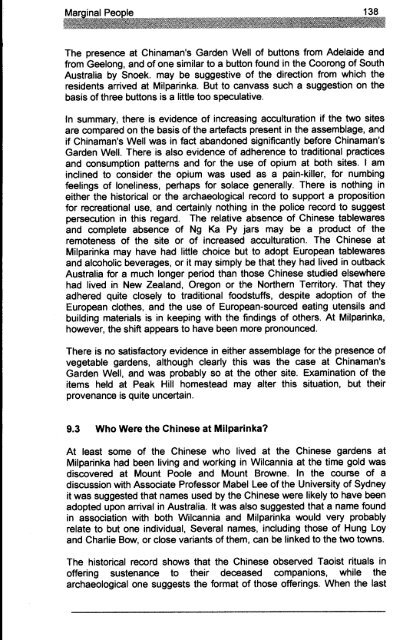Adec Preview Generated PDF File - The Sydney eScholarship ...
Adec Preview Generated PDF File - The Sydney eScholarship ...
Adec Preview Generated PDF File - The Sydney eScholarship ...
You also want an ePaper? Increase the reach of your titles
YUMPU automatically turns print PDFs into web optimized ePapers that Google loves.
<strong>The</strong> presence at Chinaman's Garden Well of buttons from Adelaide and<br />
from Geelong, and of one similar to a button found in the Coorong of South<br />
Australia by Snoek. may be suggestive of the direction from which the<br />
residents arrived at Milparinka. But to canvass such a suggestion on the<br />
basis of three buttons is a little too speculative.<br />
In summary, there is evidence of increasing acculturation if the two sites<br />
are compared on the basis of the artefacts present in the assemblage, and<br />
if Chinaman's Well was in fact abandoned significantly before Chinaman's<br />
Garden Well. <strong>The</strong>re is also evidence of adherence to traditional practices<br />
and consumption patterns and for the use of opium at both sites. I am<br />
inclined to consider the opium was used as a pain-killer, for numbing<br />
feelings of loneliness, perhaps for solace generally. <strong>The</strong>re is nothing in<br />
either the historical or the archaeological record to support a proposition<br />
for recreational use, and certainly nothing in the police record to suggest<br />
persecution in this regard. <strong>The</strong> relative absence of Chinese tablewares<br />
and complete absence of Ng Ka Py jars may be a product of the<br />
remoteness of the site or of increased acculturation. <strong>The</strong> Chinese at<br />
Milparinka may have had little choice but to adopt European tablewares<br />
and alcoholic beverages, or it may simply be that they had lived in outback<br />
Australia for a much longer period than those Chinese studied elsewhere<br />
had lived in New Zealand, Oregon or the Northern Territory. That they<br />
adhered quite closely to traditional foodstuffs, despite adoption of the<br />
European clothes, and the use of European-sourced eating utensils and<br />
building materials is in keeping with the findings of others. At Milparinka,<br />
however, the shift appears to have been more pronounced.<br />
<strong>The</strong>re is no satisfactory evidence in either assemblage for the presence of<br />
vegetable gardens, although clearly this was the case at Chinaman's<br />
Garden Well, and was probably so at the other site. Examination of the<br />
items held at Peak Hill homestead may alter this situation, but their<br />
provenance is quite uncertain.<br />
9.3 Who Were the Chinese at Milparinka?<br />
At least some of the Chinese who lived at the Chinese gardens at<br />
Milparinka had been living and working in Wilcannia at the time gold was<br />
discovered at Mount Poole and Mount Browne. In the course of a<br />
discussion with Associate Professor Mabel Lee of the University of <strong>Sydney</strong><br />
it was suggested that names used by the Chinese were likely to have been<br />
adopted upon arrival in Australia. It was also suggested that a name found<br />
in association with both Wilcannia and Milparinka would very probably<br />
relate to but one individual, Several names, including those of Hung Loy<br />
and Charlie Bow, or close variants of them, can be linked to the two towns.<br />
<strong>The</strong> historical record shows that the Chinese observed Taoist rituals in<br />
offering sustenance to their deceased companions, while the<br />
archaeological one suggests the format of those offerings. When the last




